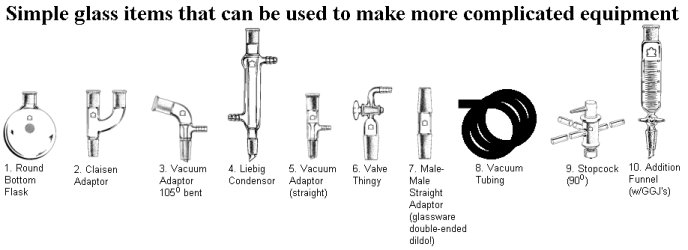Simple Glass to Fancy Glassby MaDMAx
I had some homework to do, so I was playing with Paintshop Pro instead. Here are some pics I made for you bees with fancy needs, but only simple glass. The first pic is just a numbered list of some simple pieces of glass that can usually be found without resorting to a chem-glass supplier (except maybe for my favorite piece, #7, the double-ended dildo for glassware! ). Sorry if the resolution on the first figure is kind of sucky, I had to shrink it to make sure it would fit on everyone's screen without making them scroll sideways.
Oh, and one more thing, you should always put hose clamps on the hose connections. I didn't bother drawing them in though. 
Figure 1. Common, simple glassware items often found at auction sites and other non-supplier places. Pressure equalized addition funnel: A pressure equalized addition funnel can be make by assembling the components as seen in figure 2. 
Figure 2. Assembly of a pressure equalized addition funnel. Dean-Stark receiver: Dean-Stark receivers are useful for removing water (or other species) from a reaction via azeotropic distillation while returning the reaction solvent to the flask. Construction of one is diagrammed in figure 3. 
Figure 3. Assembly of a pressure equalized addition funnel. Fraction receiver Fraction receivers are very handy pieces of equipment to have when performing fractional distillations. They allow the changing of the receiving flask without interrupting the distillation (i.e. without releasing vacuum). Figure 4 shows how one can be built. 
Figure 4. Components of a fraction receiver. Figure 5 shows the operation of the fraction receiver. When you have distillate coming over (collecting a fraction), you will want to have stopcock #1 open (so that the distillate falls into the receiving flask), and stopcock #2 open (so vacuum is maintained in the entire system. When the first fraction stops coming over, and the second starts to, you should close #1 (the distillate will stay in the funnel), and close #2 (so that the vacuum is released in the receiving flask). Remove your receiving flask, pour it out into an appropriate container, clean quickly, then re-attach it. Then slowly open #2 to pull a vacuum in the receiving flask, but do it slowly so that the vacuum in the rest of the system is not disturbed too much. Once #2 is all the way open, and the receiving flask evacuated, open #1 to let the next fraction go into the receiving flask. And repeat as needed. 
Figure 5. Operation of a fraction receiver. |